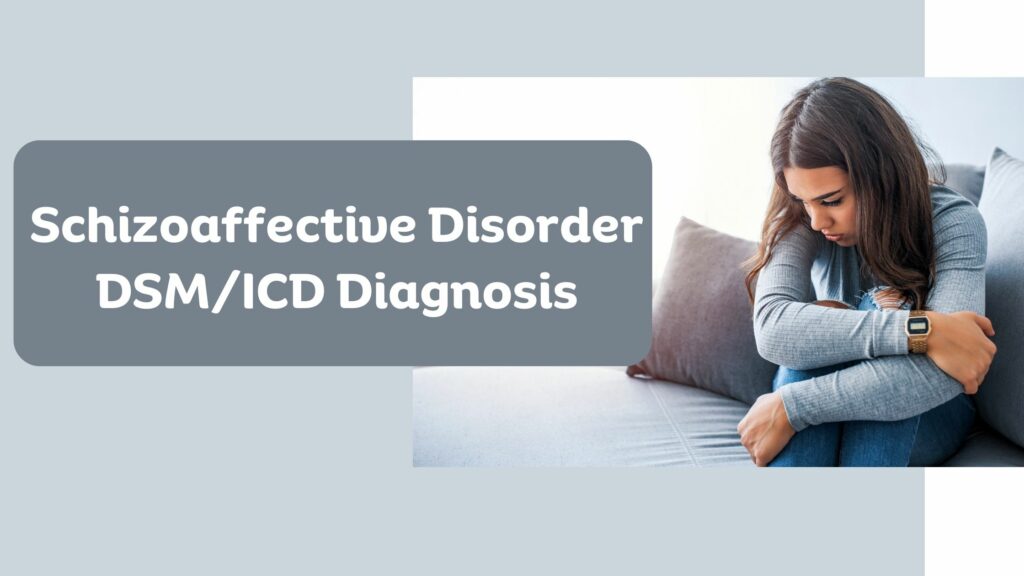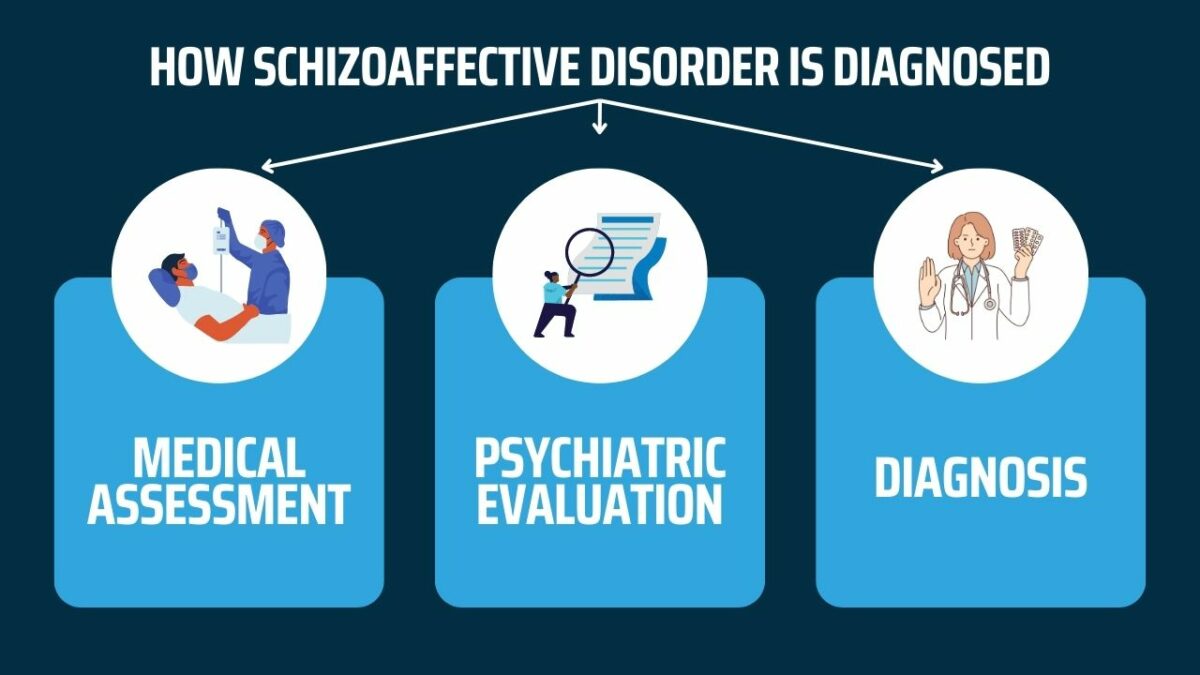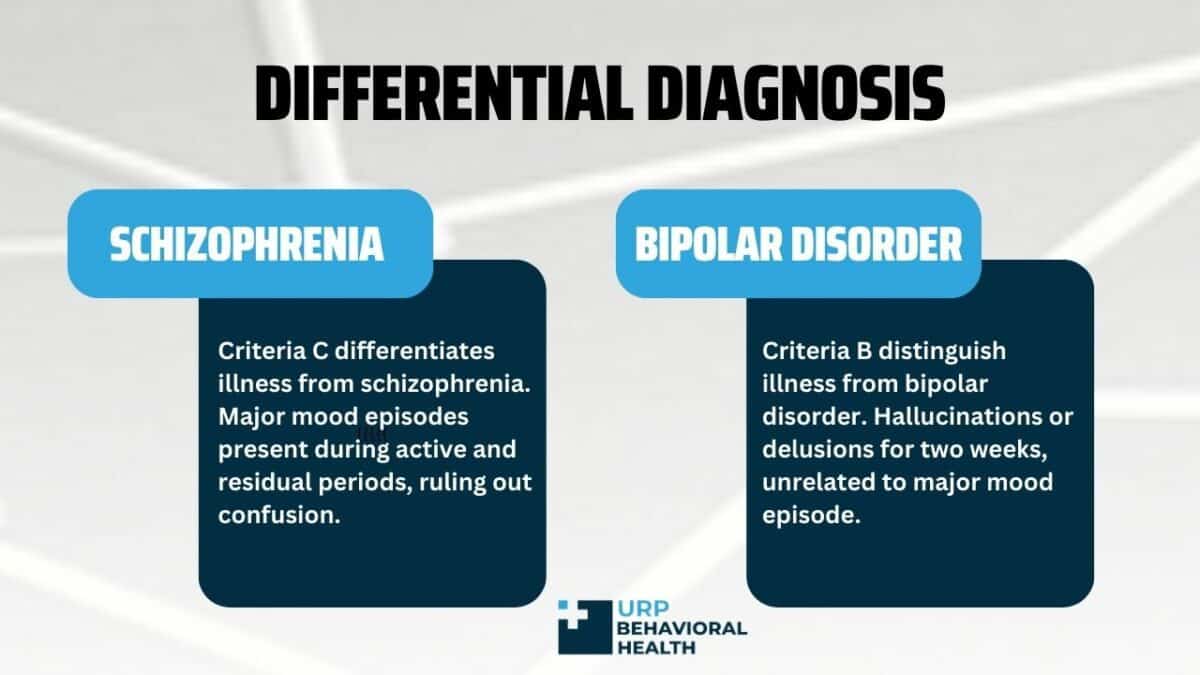Schizoaffective Disorder DSM/ICD Diagnosis

To provide appropriate treatment for a disorder, mental health professionals must understand what it is. This is especially the case for conditions with psychotic symptoms. Schizoaffective disorder is often diagnosed incorrectly as schizophrenia with a major mood episode or as a major mood disorder with psychotic symptoms. But what makes this classification different from other disorders? More importantly, how do psychiatrists diagnose it? Let’s explore the diagnosis criteria.

How Schizoaffective Disorder is Diagnosed at URP Behavioral Health
At URP Behavioral Health, an interdisciplinary team of experts performs different assessments for an accurate diagnosis. It involves extensively looking at your physical and psychological health before making a decision.
Medical Assessment
The first step involves performing a medical assessment. Here, your physician will look at your medical history to see if you’ve inherited any conditions from your family. Some common diseases that are inherited include heart problems or diabetes. They’ll check your healthcare records to see if you’ve gotten any major operations done. This helps the team rule out the possibility that you’re experiencing a disturbance due to a physical condition. The assessment also includes blood tests to ensure that you’re not experiencing symptoms due to the effect of substance use.
Psychiatric Evaluation
The next step involves performing a psychiatric evaluation, during which they’ll ask about the symptoms you’re experiencing. They’ll also ask if you’ve faced some changes since the onset of symptoms and how these changes have affected your ability to function. To corroborate your account of the symptoms, they may also ask to speak with loved ones who live with you, such as a spouse, parents, or siblings, who can describe the changes in your behavior. This will also help assess your impairment in daily functioning.
Diagnosis
After performing different tests to understand your physical and psychological health, your mental health provider will conduct a diagnosis. For a diagnosis, you need to meet the criteria mentioned in the DSM-5 and the ICD-10.

Schizoaffective Disorder DSM-5 Diagnostic Criteria
Your mental health practitioner will see if you meet the following criteria as provided in the APA’s Diagnostic and Statistical Manual of Mental Disorders.
1. During an uninterrupted period of your illness, you should experience both a major mood episode and criterion A of schizophrenia. (Do note that you should experience criterion A1, low mood, during the major depressive episode). According to criterion A of schizophrenia, you have to experience at least two of the following for a two-month period, one of which must be the first, second, or third symptom.
- Hallucinations
- Delusions
- Disorganized behavior
- Disorganized speech
- The absence of motivation, interest, and social engagement
2. Have hallucinations or delusions for two weeks (or more) in the absence of a major mood episode during the entire duration of your illness.
3. You meet the criteria for a major mood episode for a majority of the duration of your illness – including both active and residual portions.
4. The mental disturbance shouldn’t occur as a result of another medical condition or substance abuse.
Bipolar Type
When diagnosing you with schizoaffective disorder, your mental health practitioner must specify the type. The bipolar subtype specifier is used if you have manic episodes and depressive episodes during the illness.
Depressive Type
The depressive subtype specifier is used if you only experience major depressive episodes.
Schizoaffective ICD-11 Criteria (6A21)
According to the WHO’s ICD-11, you must meet the diagnostic requirements of schizophrenia with a manic, mixed, or depressive episode (moderate or severe) within the same period of the illness. They should occur simultaneously or a few days apart. You experience:
- Prominent symptoms of schizophrenia, such as hallucinations, delusions, and disorganized speech or behavior, and;
- Symptoms of a depressive, manic, or mixed episode.
- Psychomotor disturbances such as catatonia may be present as well.
The symptoms should continue for at least one month, and they shouldn’t occur due to substance abuse or another health condition.
In both forms of diagnosis, your mental health practitioner will specify if you’re currently in the first episode or have encountered multiple episodes of the illness. They will also specify if you’re currently symptomatic, in partial remission, or in full remission. In the event that your mental health practitioner is unable to determine whether you’re currently experiencing your first episode or have gone through multiple episodes, they will diagnose it as unspecified.

Differential Diagnosis
Schizophrenia
By meeting criteria C, you differentiate the presentation of your illness from that of schizophrenia. According to the criteria, you meet the criteria for a major mood episode during active and residual periods of the illness. This eliminates any confusion that you could be experiencing mood disturbances as a result of schizophrenic symptoms.
Bipolar Disorder
By meeting criteria B, you differentiate the presentation of your illness from bipolar disorder. According to criteria B, you must have hallucinations or delusions for two weeks in the absence of a major mood episode. This eliminates any confusion that you could be experiencing psychotic symptoms as a result of your major mood episode.
FAQs
Some of the commonly asked questions about schizoaffective disorder include:
There’s no specific cause of schizoaffective disorder. Rather, it occurs due to a combination of factors. This can include stressful life events, childhood trauma, alterations in their brain chemistry, and a family history of schizophrenia or bipolar disorder.
URP Behavioral Health treats schizoaffective disorder using a combination of evidence-based and holistic therapies over the course of a residential treatment program. In addition, the program also focuses on private living conditions, balanced meals, and a focus on wellness for the best outcomes.
Schizoaffective disorder is the combination of schizophrenic symptoms and a major mood episode. That means you experience psychotic symptoms like hallucinations and delusions, negative symptoms, and depressive symptoms. Depending on the type of schizoaffective disorder, you may also have manic episodes.
References
Let us guide you towards healing
We know that seeking treatment can be overwhelming, but our staff is here to make the process as smooth as possible. We’re available 24/7 to address any questions or concerns you may have.

